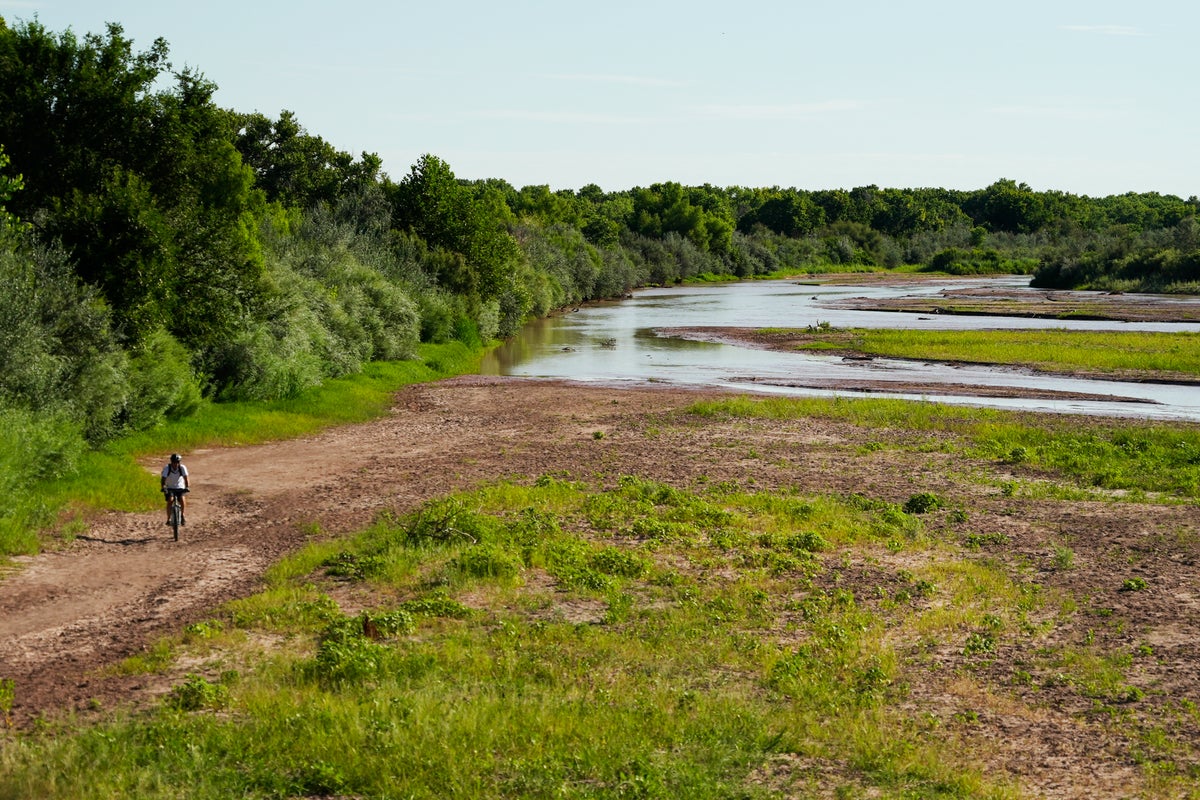
With several billion dollars in federal money secured for drought-stricken western states, managers and officials on the Rio Grande are hopeful some will reach their communities and bring attention to the challenges facing one of North America’s longest rivers.
Stretches of the river near Albuquerque, New Mexico went dry for the first time in 40 years in August, destroying critical habitat for endangered fish. South Texas cities including McAllen, Brownsville and Mission, whose only water source is the river, ratcheted up water restrictions on businesses and a collective 1 million people. Reservoirs that are key to those residents, but not household names, like Amistad and the Falcon Lakes, fell to all-time lows. Farmers in the Rio Grande Valley braced for losses when drought caused interruptions to deliveries from canals that normally bring them water.
With $4 billion in the Biden administration’s climate measure to address drought, some officials argue cities and farms in the Rio Grande basin have been overlooked while facing just as many problems as others in the West. The money from the federal spending package has not yet been fully allocated, but priority will be given to states served by the 1,450-mile (2,334-kilometer) powerhouse of the West, the Colorado River, and to other drought-afflicted basins. Officials in New Mexico and Texas want the Rio Grande to be included.
A main way the money will be spent in the Colorado River basin is to pay farmers to leave fields unplanted and free up the water that would otherwise be used. Southwestern cities and Native American tribes, who have their own rights to water, could also be paid to use less of their supply.
Over the years, Rio Grande communities have received federal grant funding and loans for infrastructure repairs and conservation, but officials say the current moment is unique because the Interior Department and other federal agencies are flush with cash from spending packages passed under the Biden administration.
New Mexico has received “bits and pieces of things,” said Mike Hamman, the state water engineer. “But nothing like a major drought appropriation strictly from the federal government, to date.”
In Texas, Maria Elena-Giner helps oversee treaties that govern how the U.S. and Mexico share the Rio Grande and Colorado River as the U.S. representative to the International Boundary and Water Commission.
Key differences between the two rivers make managing South Texas' water supply challenging, Giner said. In South Texas, 70% of water from the Rio Grande comes from tributaries located in Mexico. The southern neighbor is to deliver water to the U.S. in five-year cycles, or send smaller increments yearly. But Mexico’s water deliveries have grown increasingly unpredictable as drought cuts into both countries' water supply.
Additional money could be put toward new water storage projects and improvements to existing dams, canals, and reservoirs in both countries, Giner said. “The big challenge is really some predictability ... on an annual basis.”
The situation on the Rio Grande is unlike the Colorado River, where Mexico is last in line for water. The northwestern Mexican states of Baja California and Sonora use Colorado River water while Chihuahua, to the east, relies on the Rio Grande.
Giner added that whereas the Colorado has the powerful Bureau of Reclamation as a manager, the Rio Grande has the International Boundary and Water Commission, a little-known diplomatic agency headquartered in El Paso, with nowhere near the same manpower to handle transboundary water issues.
“We are the Bureau of Reclamation on the Rio Grande,” she said, pointing to the commission's $55 million annual budget for the entire U.S-Mexico border.
But Democratic U.S. Rep. Melanie Stansbury of New Mexico said the problems of the three-state Rio Grande basin go beyond money. She wants to reform how the river is managed, and introduced legislation in Congress last summer to bring more coordination between the basin states, arguing that policies should be updated to match current climate conditions in the Southwest.
Stansbury said reservoirs on the Rio Grande could be managed differently to allow for better water storage, which would help communities in times of drought. Currently, reservoirs in New Mexico have specific uses for water delivery, flood control or storage, but are rarely used for more than one purpose. And adding more coordination among states would allow them to make better use of funding that's available, she said.
“On the Rio Grande, there’s not a set of common goals because that management framework doesn’t exist for the entire basin,” Stansbury said. Her bill is part of a larger drought and wildfire package that the Senate will likely vote on after the midterm elections.
The Colorado River is on a scale unmatched by any other North American river, serving 40 million people across seven states, 29 tribes and Mexico. The Rio Grande provides water to more than 6 million people in southern Colorado, New Mexico, Texas, and Mexico and irrigates thousands of square miles of farmland.
Jason Casuga, chief engineer for New Mexico's Middle Rio Grande Conservancy District, said the Rio Grande's smaller scale should make conservation easier, particularly as drought-affected states are eligible for more funding.
“The Colorado is just orders and orders of magnitude different on the scale of water, which complicates solutions," Casuga said. "Luckily, for the Rio Grande, I don't believe that's the case. There are tangible solutions to moving water for drought purposes."
___
Follow Suman Naishadham on Twitter: @SumanNaishadham







